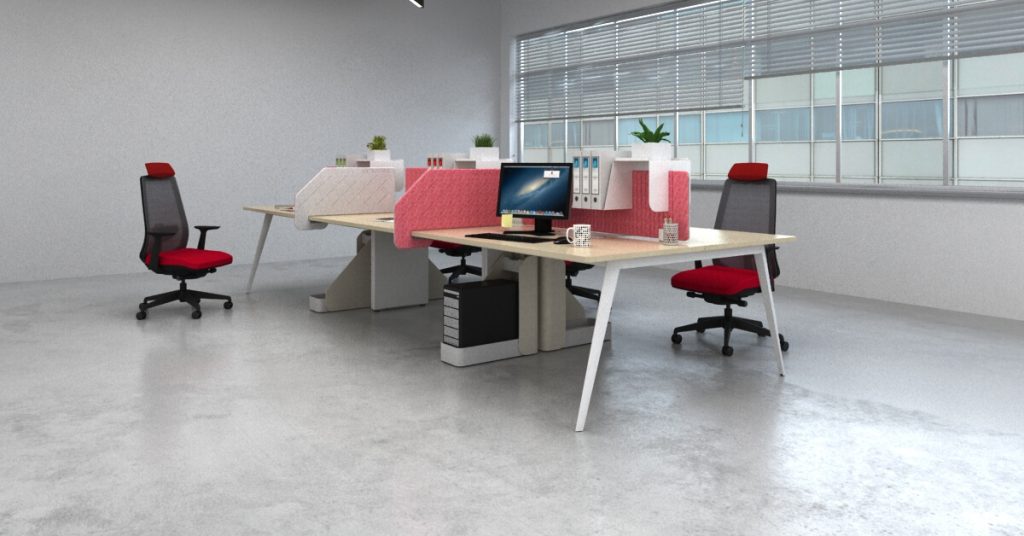
09 Apr Optimizing Your Workspace: 10 Ergonomic Tips for Desk and Chair Alignment
In today’s work culture, where long hours are spent seated at a desk, ensuring your workspace is ergonomically optimized can significantly impact your comfort and productivity. From proper chair alignment to desk setup, small adjustments can make a big difference in reducing strain and discomfort.
Here are ten ergonomic tips for aligning your desk and chair to create a more comfortable and supportive workspace.
1. Place your upper arms parallel to your spine
Maintaining proper alignment of your upper arms with your spine is important for reducing strain on your shoulders and neck. Adjust your chair’s armrests so that your arms rest comfortably at your sides with your elbows bent at a 90-degree angle. This position promotes relaxed shoulders and prevents slouching, reducing the risk of developing musculoskeletal issues.
2. Re-evaluate your sitting posture
Periodically reassess your sitting posture throughout the day to ensure you’re maintaining proper alignment and avoiding slouching or leaning forward. Sit back in your chair with your shoulders relaxed, spine aligned, and feet flat on the floor or supported by a footrest.
Making small adjustments to your posture can alleviate tension and prevent discomfort in the long run.
3. Adjust your work surface to match your height
Ensure your desk or workstation is at an appropriate height to prevent unnecessary strain on your arms and wrists. Ideally, your elbows should be at a 90-degree angle when typing or using a mouse, with your wrists in a neutral position. Use a height-adjustable desk or a keyboard tray to achieve optimal alignment and minimize the risk of repetitive strain injuries.
4. Boost your feet for support
If your feet do not comfortably reach the floor when seated, use a footrest to support them. A footrest helps maintain proper posture by relieving pressure on your thighs and reducing strain on your lower back. Adjust the footrest height so that your knees are slightly lower than your hips, promoting better circulation and preventing discomfort.
5. Measure the depth of your seat
The depth of your chair seat plays a significant role in supporting your lower back and promoting good posture. Sit back in your chair with your back against the backrest and ensure there is a two to four-inch gap between the edge of the seat and the back of your knees.
This allows for proper weight distribution and prevents pressure on your thighs, reducing discomfort during prolonged sitting.
6. Raise your chair to support your sit-to-stand movement
Investing in an ergonomic office chair with adjustable height settings allows you to customize your seating position to support your body’s natural movements.
Set your chair height so that your feet are flat on the floor and your knees are level with or slightly below your hips. This alignment encourages proper blood circulation and reduces pressure on your lower back.
7. Adjust your chair’s swivel and back support
Most ergonomic chairs come with adjustable features such as swivel and back support to accommodate different body types and preferences. Set the chair’s swivel tension to allow for easy movement without straining your muscles.
Adjust the backrest height and angle to provide adequate lumbar support and maintain the natural curve of your spine, promoting a healthy sitting posture.
8. Choose a mouse that fits your hand
Selecting the right mouse size and shape is necessary for preventing hand and wrist strain during prolonged computer use. Opt for a mouse that fits comfortably in your hand and allows for a relaxed grip without excessive bending of the wrist.
Consider using an ergonomic mouse with additional support features to reduce the risk of developing repetitive strain injuries such as carpal tunnel syndrome.

9. Watch the height of your screen
Position your computer monitor or screen at eye level to prevent neck strain and promote proper alignment of your head and spine. Adjust the monitor height so that the top of the screen is at or slightly below eye level when seated.
Use a monitor stand or riser if necessary to achieve the optimal viewing angle and reduce discomfort associated with looking up or down for extended periods.
10. Adjust your armrest to support your shoulders
If your chair is equipped with armrests, adjust them to support your shoulders and upper arms comfortably. Position the armrests so that they are level with your desk surface and allow your arms to rest naturally at your sides.
Properly adjusted armrests can help alleviate shoulder tension and reduce the strain on your neck and upper back while typing or using a mouse.
Key Takeaways for Ergonomic Tips for Desk and Chair
All in all, by implementing these ergonomic tips for desk and chair alignment, you can create a more comfortable and supportive workspace that promotes productivity and overall well-being.
Remember to make adjustments based on your individual needs and preferences, and prioritize your health and comfort while working long hours at your desk.

Sorry, the comment form is closed at this time.